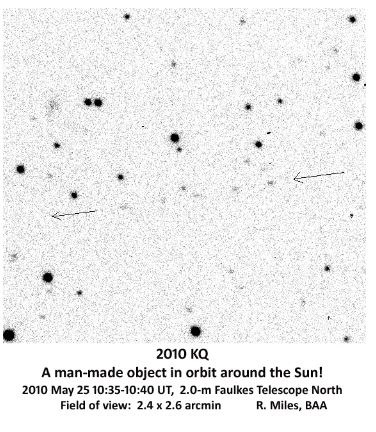Artificial object found orbiting Sun

The Catalina Sky Survey (CSS) is a project based at the University of Arizona which is scanning the Solar System to find and catalogue all asteroids and comets with orbits that might bring them in close proximity to Earth. Such a catalogue is essential if we are ever to have an early warning system to detect large objects which might collide with the Earth, such as the Chicxulub impact which is generally believed to have been responsible for the extinction of the Dinosaurs.
On 19 May, CSS found a new object and added it to the catalogue as “2010 KQ” to await orbital analysis. Richard Miles, using the Faulkes Telescope North, began to suspect that the object might have a human origin. First, it’s orbit was very circular and very closely matches Earth’s orbit (It takes 1.04 years to orbit the Sun). Secondly, the colour didn’t match any natural asteroids. Spectrographic analysis of the light reflected from the object revealed a close match to Titanium Oxide Paint (once compensation was made for prolonged Ultra-violet exposure). He captured an image of the object, shown to the left.
Richard believes that the object could be debris from the old Soviet space program. Specifically, he thinks that it is the fourth stage of the Russian Proton rocket which transported the Luna 23 sample return project. The probe was launched on 28 October 1974, and the discarded 4th stage was 5.7 meters in length. Attempts to precisely match the object to the Luna 23 mission by backtracking its orbit have proved difficult however — being not much more than an empty fuel tank, the 4th stage is very light for its size and so could be gently pushed off its predicted course by the Solar Wind.
Edward Gomez of Las Cumbrez Observatory has more detail on his blog here:
